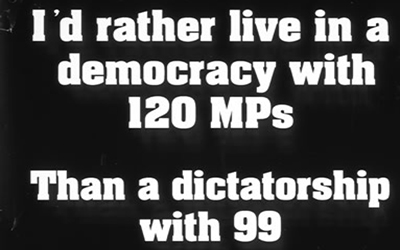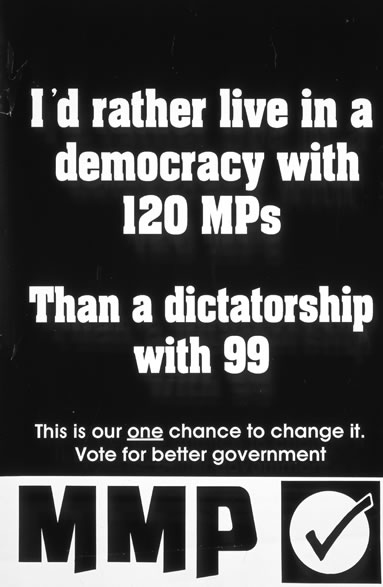What’s to fix with mixed-member proportional


Lest We Forget: Mixed-member proportional needs a tune-up, rather than return to pre-1996 days when governments, sometimes elected with fewer votes than the opposition, could rule with impunity. Poster Electoral Reform Coalition
Updated 16 November 2011
The member of Parliament’s ‘What’s to fix with mmp’ wasn’t rhetorical, and consequently the editor was somewhat taken aback.
It was a sharp reminder that opinion on mixed-member proportional is, mixed. That it is either a huge improvement on first-past-the-post, or not. Currently, only a tiny minority fall into a third camp—those who, while seeing it as a huge improvement, see it in urgent need of a tune-up.
The mixed-member proportional system of representation has been used for the last four central government elections in Aotearoa. Mixed-member proportional, as the name suggests, is a form of proportional representation. Its particular strong point is that, by using some non-electorate representatives, the final make up of the Parliament is almost exactly proportional to the party vote.
The other feature that is valued is that it allows for single representative electorates—other forms of proportional representation involve multi-seat electorates meaning that they are geographically larger, which is generally contrary to the ideal of district representation. And in sparsely populated areas, this becomes a major consideration—most of the landmass of the South Island is currently divided into just four mammoth electorates—whose representatives’ carbon footprint doesn’t bear thinking about.
Now, the editor may be committing an offence here, but he counted votes cast in the 2005 general election. The patterns of voting observed, in respect to electorate and party vote, were disturbing. A significant number of voters appeared to not understand how to express their intention. For example, there was a pattern where the electorate vote was given to the Green candidate, and the party vote to Labour—the same pattern was apparent in the National–New Zealand First voting. (Entirely in the interests of simplicity, this discussion uses the Green–Labour example, but in no way should this be seen to reflect the sympathies of the Mahurangi Magazine.) The effect of these two ticks was to vote Labour, period—the Green Party gained no benefit. There was no local effect, as minor parties have no realistic opportunity of winning electorates—the exception, of course, are the few that sport highly charismatic leaders. Almost certainly, the voters producing this pattern had actually intended to support the Green Party, but wished to indicate a preference for Labour over National.
Preference; it is the lack of preference voting that is the deficiency of the bog-standard mixed-member proportional system. Proportional voting is not preference voting. Preference is where a voter can, for example, give their first preference to the Green Party, and their second to Labour. Then, so long as the Green Party clears the threshold—which itself needs fixing—that vote goes to the Greens. If below the threshold, the vote is transferred to Labour.
The situation is similar at the electorate level. Staying with the Green–Labour example—the editor’s excuse is that Mahurangi Magazine readers are assumed to have at least a modicum of interest in ‘the environment’—a voter can, for example, give their first preference to the Green candidate, and their second to the Labour candidate. Assuming that, as in Rodney, the Green candidate doesn’t stand a prayer, the voter’s second preference would go to the Labour candidate—who, in the 2005 election, was at least putting a brave face on his chances. So, there are two options:
- Tune-up the voters; or
- Tune-up the system.
Theoretically, with unlimited spending, the voters could be educated. But if this level of confusion remains after four mixed-member elections, it is clear that the money would have to be spent every three years—between elections, voters clearly forget where to put their ‘two ticks’.
‘1 2 3, tune-up mmp’ is a concept for proactively addressing the disillusionment of those who see the wielding of enormous power by minor players—the veto of the Greens by Peter Dunne, and the insistence of Winston Peters on becoming Minister of Foreign Affairs, as an outrageous abuse of the system: Disproportional representation. Such perversions are unnecessarily obscuring the huge improvement to representative democracy that the proportional system has brought.
Along with the tune-up of mixed-member proportional, with the very simple addition of preferential voting, the coattails provision can go. And because preferential voting would result in the electorates better reflecting the party vote, the overall number of list candidates could be reduced. Given the unequivocal result of the non-binding 1999 referendum to reduce the number of members to 99, this in itself would be a move that New Zealanders would welcome.
As an interim measure, minor parties (other than those hoping to exploit the coattails provision) might do themselves a favour…
…by not standing candidates for the electorate seats.
Fixing the fixed threshold Stephen Todd has invented a consummately clever solution to the utter arbitrariness of the five percent threshold. The current Parliamentary Assembly of the Council of Europe recommendation is 4%. But rather than slavishly adopt that percentage, Stephen Todd’s system for what he calls a ‘graduated threshold’ is much smarter and much less arbitrary. It works like this: The new threshold might be three percent, at which point a party would be allocated one seat. Five percent and above the party would receive full proportionality, six of the 120 seats—or five, if Parliament was reduced to 99 seats. The allocation then increases more steeply the closer a party polls to 5%.
The effect is to remove the sudden death—the political oblivion—of dropping below the dread 5% threshold.
